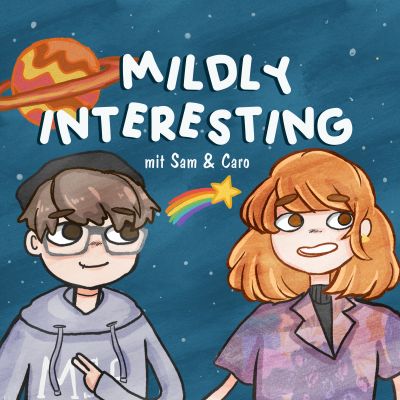Wie ändern Chamäleons ihre Farbe? Wie findet man Planeten außerhalb des Sonnensystems? Und was haben Bananen und Antimaterie miteinander zutun? Caro und Sam erzählen jede Woche von einem neuen wissenschaftlichen Phänomen, das sie (leicht) interessant finden und stoßen dabei auf alle möglichen Fragen und Antworten. Manchmal laden sie dabei auch Gäste ein, die wirklich Ahnung haben. Neue Folgen jeden zweiten (mildly) Mittwoch. Folgt uns auf Twitter unter: @mildinterestpod Dieser Podcast ist Teil der Plattform wissenschaftspodcasts.de. Produktion, Cover art: Caro Intromusik: Luca Tebben
https://podcasters.spotify.com/pod/show/mildly-interesting
#7 Bienentänze & Urzeitkrebs-Nazis
In dieser Folge erzählt Caro von ihren Lieblingstieren, nämlich Bienen, während Sam die Enstehungsgeschichte von Uhrzeitkrebsen erkärt. (Und was das mit Nazis zutun hat)
Heute war die Audioqualität nicht die allerbeste, wir hatten das was falsch eingestellt, also nicht wundern:)
Bienen:
Das Bienenbuch: ISBN: 9783831032297
Amdam, G. V., Hartfelder, K., Norberg, K., Hagen, A., & Omholt, S. W. (2004). Altered Physiology in Worker Honey Bees (Hymenoptera: Apidae) Infested with the Mite Varroa destructor (Acari: Varroidae): A Factor in Colony Loss During Overwintering? Journal of Economic Entomology, 97(3)
Evans, J. D., & Cook, S. C. (2018). Genetics and physiology of Varroa mites. Current Opinion in Insect Science, 26, 130-135.
Genersch, E., von der Ohe, W., Kaatz, H., Schroeder, A., Otten, C., Buchler, R., . . . Rosenkranz, P. (2010). The German bee monitoring project: a long term study to understand periodically high winter losses of honey bee colonies.
Klein, A.-M., Vaissière, B. E., Cane, J. H., Steffan-Dewenter, I., Cunningham, S. A., Kremen, C., & Tscharntke, T. (2007). Importance of pollinators in changing landscapes for world crops. Proceedings of the Royal Society B: Biological Sciences, 274(1608), 303-313. doi:doi:10.1098/rspb.2006.3721
Maini, S., Medrzycki, P., & Porrini, C. (2010). The puzzle of honey bee losses: a brief review. Bulletin of Insectology, 63(1), 153-160.
Switanek, M., Crailsheim, K., Truhetz, H., & Brodschneider, R. (2017). Modelling seasonal effects of temperature and precipitation on honey bee winter mortality in a temperate climate. Science of The Total Environment, 579, 1581-1587
vanEngelsdorp, D., & Meixner, M. D. (2010). A historical review of managed honey bee populations in Europe and the United States and the factors that may affect them. Journal of Invertebrate Pathology, 103, S80-S95.
https://www.bbc.com/news/science-environment-45566304
https://advances.sciencemag.org/content/5/2/eaav0961
https://www.mehr-demokratie.de/glyphosat-debatte/hintergrund/
Uhrzeitkrebse:
Idee von: Robert Evans, Behind the Bastards (Kein scheiss gönnt euch den Podcast)
Mollin, B. (1995). A Petri Dish For Racism Supremacists’ Message Spreading Through Nation, Butler Says. The Spokesman Review . Retrieved from: https://www.spokesman.com/stories/1995/jul/22/a-petri-dish-for-racism-supremacists-message/
Hughes, E. (2011)
The Shocking True Tale Of The Mad Genius Who Invented Sea-Monkeys. THe Awl. Retrieved from https://www.theawl.com/2011/06/the-shocking-true-tale-of-the-mad-genius-who-invented-sea-monkeys/
Martin, D. (2003) Harold von Braunhut, Seller of Seamonkeys, dies at 777 The New York Times Retrieved from:https://www.nytimes.com/2003/12/21/us/harold-von-braunhut-seller-of-sea-monkeys-dies-at-77.html
Brott, T. (2000) The Sea Monkeys and the white supremacist. Los Angeles Times Retrieved from: https://www.latimes.com/archives/la-xpm-2000-oct-01-tm-29473-story.html
Lambrecht, E., Baré, J., Chavatte, N., Bert, W., Sabbe, K., & Houf, K. (2015). Protozoan Cysts Act as a Survival Niche and Protective Shelter for Foodborne Pathogenic Bacteria. Applied and environmental microbiology, 81(16), 5604–5612. https://doi.org/10.1128/AEM.01031-1
Adékambi, T., Ben Salah, S., Khlif, M., Raoult, D., & Drancourt, M. (2006). Survival of environmental mycobacteria in Acanthamoeba polyphaga. Applied and environmental microbiology, 72(9), 5974–5981. https://doi.org/10.1128/AEM.03075-05
